8.2 The Endocrine System
The complex endocrine system consists of many glands, including the pituitary, thyroid, parathyroid, pineal, and adrenal glands, as well as the pancreas, ovaries, and testes. Fig 8.1 provides an overview of the endocrine system and its components. This chapter will focus on a discussion of the characteristics of and the pathologies that affect three major endocrine glands and their hormones: the adrenal glands, the pancreas, and the thyroid gland.
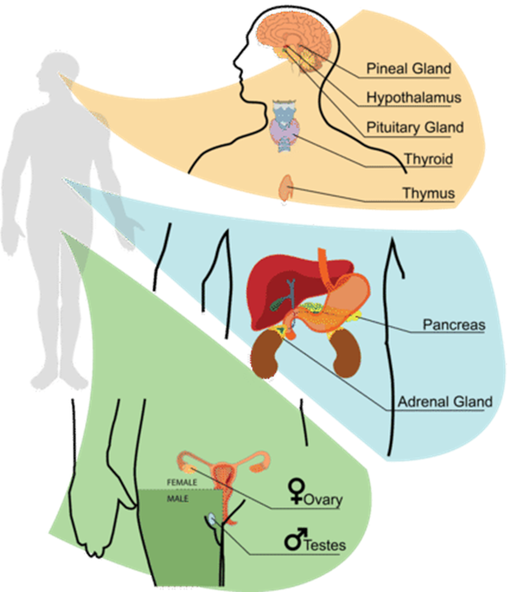
The endocrine system uses hormones for chemical signalling, similar to how the nervous system uses neurotransmitters to communicate. These hormone signals are sent by the endocrine organs and transported mostly through the bloodstream to other areas of the body. They then bind to receptors on target cells to induce a particular response. Hormone levels are tightly controlled by the body to prevent levels from becoming to high or too low, and feedback loops are the manner in which the endocrine system accomplishes this. Feedback loops govern the initiation and maintenance of hormone secretion in response to a variety of stimuli. The most common feedback loop in this system is the negative feedback loop. Negative feedback is characterized by the inhibition, or stopping, of further secretion of a hormone in response to adequate levels of that hormone. This allows blood levels of the hormone to be maintained within a narrow range. Fig. 8.2 shows an example of a negative feedback loop that governs the levels of thyroxine (T3) and triiodothyronine (T4) in the blood.
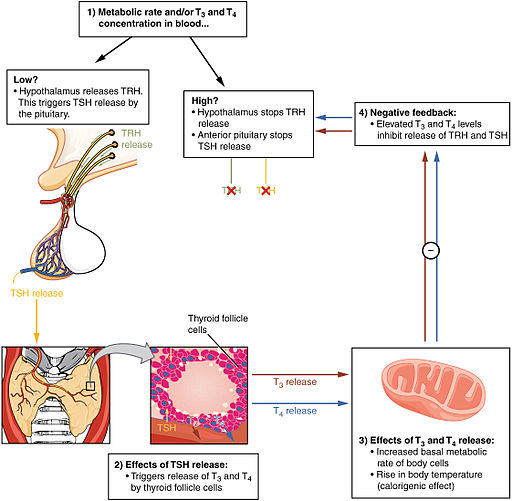
(TED-Ed, 2018)
The Adrenal Glands
There are two adrenal glands, one on each kidney, as shown in Fig. 8.3. Each adrenal gland consists of the adrenal cortex, which is composed of glandular tissue, and the adrenal medulla, which is made up of nervous tissue. The adrenal cortex and medulla each secrete its own set of hormones. One of the major functions of the adrenal glands is to respond to stress. The body responds in different ways to short-term stress and long-term stress. The reaction to short-term stress, also called the fight-or-flight response, is mediated by the hormones epinephrine and norepinephrine secreted by the adrenal medulla. Their function is to prepare the body for physical exertion. But if the stress continues for a longer time, the adrenal cortex hormone cortisol then mediates body responses such as depression, suppressed immune response, or severe fatigue.
The adrenal cortex also produces steroid hormones, which are important for regulating blood pressure and blood volume, nutrient uptake and storage, fluid and electrolyte balance, and inflammation. Adrenal hormones also have several non-stress-related functions, including the increase of blood sodium and glucose levels.
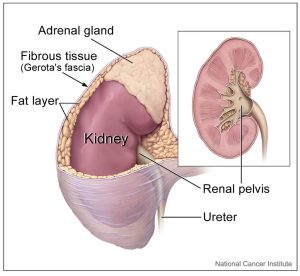
The Pancreas
The pancreas, shown in Fig. 8.4, is a long, slender organ located near the stomach. Pancreatic islets, which are a group of cells that produce hormones, secrete glucagon and insulin. Glucagon plays an important role in blood glucose regulation because low blood glucose levels stimulate its release. On the other hand, elevated blood glucose levels stimulate the release of insulin.
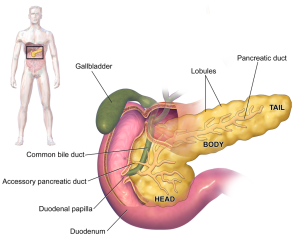
Glucagon
Receptors in the pancreas can sense a decrease in blood glucose levels, which may occur during periods of fasting or prolonged exercise. In response, the alpha cells of the pancreas secrete the hormone glucagon, which eventually results in an increase in glucose levels. The activity of glucagon is regulated through a negative feedback loop whereby rising blood glucose levels inhibit further glucagon production and secretion.
Insulin
Insulin facilitates the uptake of glucose into skeletal and adipose body cells. The presence of food in the intestines triggers the release of various gastrointestinal tract hormones, which then trigger insulin production and secretion by the beta cells of the pancreas. Once nutrient absorption begins to occur in the digestive tract, blood glucose levels increase, which further stimulates insulin secretion. The release of insulin is also regulated through a negative feedback loop—as blood glucose levels decrease, further insulin release is inhibited.
The Thyroid Gland
The thyroid gland, shown in Fig. 8.5, is a butterfly-shaped organ located anterior to the trachea, just below the larynx. Each lobe of the thyroid is embedded with parathyroid glands. The thyroid secretes the hormones thyroxine (T4) and triiodothyronine (T3), which are often referred to as metabolic hormones because their levels influence the body’s basal metabolic rate, the amount of energy used by the body at rest. A negative feedback loop controls the regulation of thyroid hormone levels. Low blood levels of T3 and T4 stimulate the release of thyrotropin-releasing hormone (TRH) from the hypothalamus, which triggers the secretion of thyroid-stimulating hormone (TSH) from the anterior pituitary. In turn, TSH stimulates the thyroid gland to secrete T3 and T4.
Thyroid hormones are critical for the normal development of the nervous system both in utero and in early childhood, and they support neurological function in adults. When levels of T3 and T4 hormones are high, the heart rate accelerates, the heartbeat strengthens, and blood pressure increases. Because thyroid hormones regulate metabolism, heat production, protein synthesis, and many other body functions, thyroid disorders can have severe and widespread consequences.
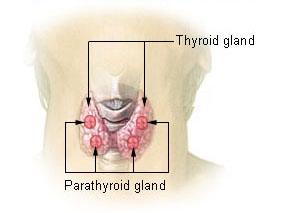
The thyroid gland also secretes another hormone called calcitonin. Calcitonin is released in response to elevated blood calcium levels. It decreases blood calcium concentrations by doing the following:
- It inhibits the activity of osteoclasts (bone cells that break down bone matrix and release calcium into blood circulation).
- It decreases calcium absorption in the intestines.
- It increases calcium loss in the urine.
Calcium is critical for many biological processes and is essential for muscle contraction, nerve impulse transmission, and blood clotting.
Table 8.1. Hormones Associated with the Adrenal Glands, Pancreas, and Thyroid
| Endocrine gland | Hormone(s) | Effect |
| Adrenal (cortex) | Aldosterone | Increases blood sodium levels |
| Adrenal (cortex) | Cortisol | Increases blood sugar levels |
| Adrenal (medulla) | Epinephrine, norepinephrine | Stimulates fight-or-flight response |
| Pancreas | Insulin | Reduces blood glucose levels |
| Pancreas | Glucagon | Increases blood glucose levels |
| Thyroid | Thyroxine (T4), triiodothyronine (T3) | Stimulates basal metabolic rate |
| Thyroid | Calcitonin | Reduces blood calcium levels |
(Ernstmeyer & Christman, 2020)
Attribution
Unless otherwise indicated, material on this page has been adapted from the following resource:
Ernstmeyer, K., & Christman, E. (Eds.). (2020). Nursing pharmacology. Chippewa Valley Technical College. https://wtcs.pressbooks.pub/pharmacology/, licensed under CC BY 4.0
References
Betts, J. G., Young, K. A., Wise, J. A., Johnson, E., Poe, B., Kruse, D. H., Korol, O., Johnson, J. E., Womble, M., & DeSaix, P. (2013). Anatomy and physiology. OpenStax. https://openstax.org/details/books/anatomy-and-physiology, licensed under CC BY 4.0
TED-Ed. (2018, June 21). How do your hormones work? – Emma Bryce [Video] YouTube. https://www.youtube.com/watch?v=-SPRPkLoKp8
Image Credits (images are listed in order of appearance)
Endocrine system glands by Mariana Ruiz Villarreal, CC BY-SA 3.0
1813 A Classic Negative Feedback Loop by OpenStax, CC BY 3.0
Kidney and adrenal gland by National Cancer Institute, Public domain
Blausen 0699 PancreasAnatomy2 by BruceBlaus, CC BY 3.0
Illu thyroid parathyroid by National Cancer Institute, Public domain

